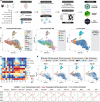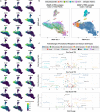Mass cytometric analysis of the immune cell landscape after traumatic brain injury elucidates the role of complement and complement receptors in neurologic outcomes
- PMID: 37308987
- PMCID: PMC10258994
- DOI: 10.1186/s40478-023-01583-0
Mass cytometric analysis of the immune cell landscape after traumatic brain injury elucidates the role of complement and complement receptors in neurologic outcomes
Abstract
Following traumatic brain injury (TBI), a neuroinflammatory response can persist for years and contribute to the development of chronic neurological manifestations. Complement plays a central role in post-TBI neuroinflammation, and C3 opsonins and the anaphylatoxins (C3a and C5a) have been implicated in promoting secondary injury. We used single cell mass cytometry to characterize the immune cell landscape of the brain at different time points after TBI. To specifically investigate how complement shapes the post-TBI immune cell landscape, we analyzed TBI brains in the context of CR2-Crry treatment, an inhibitor of C3 activation. We analyzed 13 immune cell types, including peripheral and brain resident cells, and assessed expression of various receptors. TBI modulated the expression of phagocytic and complement receptors on both brain resident and infiltrating peripheral immune cells, and distinct functional clusters were identified within same cell populations that emerge at different phases after TBI. In particular, a CD11c+ (CR4) microglia subpopulation continued to expand over 28 days after injury, and was the only receptor to show continuous increase over time. Complement inhibition affected the abundance of brain resident immune cells in the injured hemisphere and impacted the expression of functional receptors on infiltrating cells. A role for C5a has also been indicated in models of brain injury, and we found significant upregulation of C5aR1 on many immune cell types after TBI. However, we demonstrated experimentally that while C5aR1 is involved in the infiltration of peripheral immune cells into the brain after injury, it does not alone affect histological or behavioral outcomes. However, CR2-Crry improved post-TBI outcomes and reduced resident immune cell populations, as well as complement and phagocytic receptor expression, indicating that its neuroprotective effects are mediated upstream of C5a generation, likely via modulating C3 opsonization and complement receptor expression.
Keywords: Complement; Complement inhibition; Mass cytometry; Microglia; Neuroinflammation; Traumatic brain injury.
© 2023. This is a U.S. Government work and not under copyright protection in the US; foreign copyright protection may apply.
Conflict of interest statement
The authors declare no competing interests.
Figures






Similar articles
-
Complement propagates visual system pathology following traumatic brain injury.J Neuroinflammation. 2024 Apr 17;21(1):98. doi: 10.1186/s12974-024-03098-4. J Neuroinflammation. 2024. PMID: 38632569 Free PMC article.
-
Identifying the Role of Complement in Triggering Neuroinflammation after Traumatic Brain Injury.J Neurosci. 2018 Mar 7;38(10):2519-2532. doi: 10.1523/JNEUROSCI.2197-17.2018. Epub 2018 Feb 6. J Neurosci. 2018. PMID: 29437855 Free PMC article.
-
Chronic complement dysregulation drives neuroinflammation after traumatic brain injury: a transcriptomic study.Acta Neuropathol Commun. 2021 Jul 19;9(1):126. doi: 10.1186/s40478-021-01226-2. Acta Neuropathol Commun. 2021. PMID: 34281628 Free PMC article.
-
Cellular players that shape evolving pathology and neurodegeneration following traumatic brain injury.Brain Behav Immun. 2018 Jul;71:9-17. doi: 10.1016/j.bbi.2018.03.033. Epub 2018 Mar 27. Brain Behav Immun. 2018. PMID: 29601944 Review.
-
Tackling Neuroinflammation After Traumatic Brain Injury: Complement Inhibition as a Therapy for Secondary Injury.Neurotherapeutics. 2023 Jan;20(1):284-303. doi: 10.1007/s13311-022-01306-8. Epub 2022 Oct 12. Neurotherapeutics. 2023. PMID: 36222978 Free PMC article. Review.
Cited by
-
Complement propagates visual system pathology following traumatic brain injury.J Neuroinflammation. 2024 Apr 17;21(1):98. doi: 10.1186/s12974-024-03098-4. J Neuroinflammation. 2024. PMID: 38632569 Free PMC article.
-
Exploring Molecular Pathways in Exercise-Induced Recovery from Traumatic Brain Injury.Med Sci Monit. 2025 Apr 12;31:e946973. doi: 10.12659/MSM.946973. Med Sci Monit. 2025. PMID: 40219599 Free PMC article. Review.
References
Publication types
MeSH terms
Substances
Grants and funding
LinkOut - more resources
Full Text Sources
Medical
Research Materials
Miscellaneous

